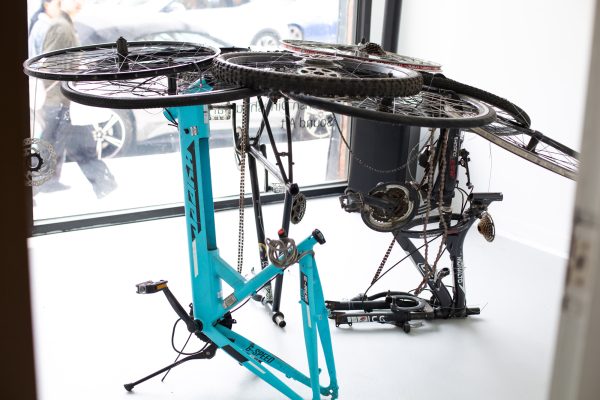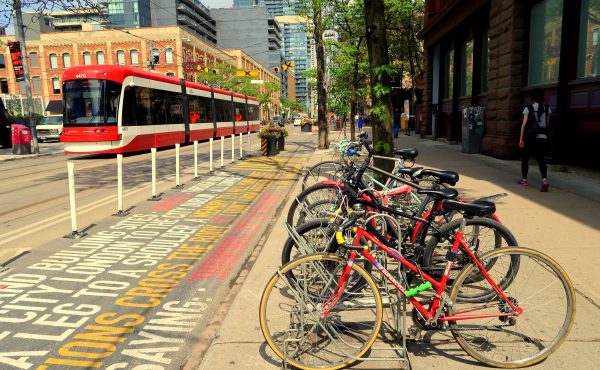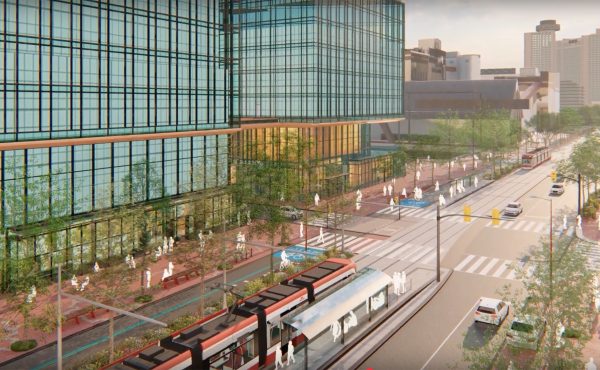Spacing’s cycling columnist Sabat Ismail met with Krish Dineshkumar, creator of Derailing Dignity, which was exhibited during the 2025 Mayworks Festival from May 16th to 28th at Whippersnapper Gallery. The installation is an exhibit mediating the experiences of migrant workers in Toronto who use bicycles to deliver food. The physical installation and accompanying sound piece concentrate on the intersection between gig work and migrant labour.
Krish Dineshkumar is a cook, composer and sound artist. He has worked as a sound designer and archival researcher in various audio productions. Krish has contributed to art installations by the Tamil Archive Project, which is exhibited at InterAccess, The Public Studio, and Lakeshore Arts. In his audio practice, he’s drawn to archiving forgotten histories and engaging with narratives that hold complexity.
Sabat Ismail: Can you begin by introducing yourself and the exhibit?
Krish Dineshkumar: I’ve worked as an artist, cook, and audio and podcast producer. Derailing Dignity came to be as a part of the Mayworks Labour Arts Catalyst Program. Mayworks is an organization and Festival that puts on programming at the intersection of arts, labour, and justice. The Labour Arts Catalyst Program partners with artists to collaborate with labour organizations. The artist then creates art informed by the work of said organization, but also by the workers.
SI: Please describe the installation more, so that readers unfamiliar can get a sense of it.
KD: The art piece was a physical installation accompanied by sound art. The physical installation was a dining table that was built exclusively from abandoned or broken bicycle parts. The parts included in the table are wheel rims and bicycle frames, which I used to emulate table legs. The wheel rims were bound together using metal twine, to emulate a tabletop.
The dining table felt like a clear way to express my ideas because it is a place to sit and eat, and tables are generally also metaphors for stability and structure, whether in our lives or societally. The table appears unappealing, uneven, and as if it could fall over at any moment, which was intentional. I wanted it to represent the very fragile nature of the systems we build up, uphold and consent to sustain our comforts. Despite how rigid it looks, it’s so faulty and fragile that it could fall over at any moment.
The sound piece was a mixture of sounds from the city familiar to those delivering food on bikes: a bell ringing and an order notification sound on the Uber Eats app. Also interspersed are interviews that I conducted with migrant workers. Building these relationships highlighted stories, experiences, and perspectives on life as a gig worker and migrant: their hopes, dreams, and ambitions, as well as reconciling their perception from Canadians, both as migrants and gig workers. The folks I spoke to underscored the intensity of the labour and how gruelling and challenging this work is but kept telling me it was a money maker and a way to set up a life for themselves in Canada.
Although gig work is taken up on bikes and cars, I wanted to capture what I think is the visual intervention of people delivering food on bicycles because there is not the same anonymity that might exist for someone who’s driving a car—there’s a very clear visual that exists around someone delivering food in Toronto, which is that there’s a giant branded food bag on the back of their bike.
This visibility is also at the crux of a lot of implicit and explicit racist dialogue around migrants taking on this work; this is where it also interacts with bike infrastructure and policy in the city, and where these conversations devolve. Making statements like “they’re treating it like the Wild West,” largely without consideration of who it is on this bicycle and whether there have been any intervention opportunities for education or to discuss, “Hey, this is what bike lanes are for”—essentially, taking an approach that considers others’ safety, comfort, and agency and bridging gaps whether through clinics or something more ad hoc, organizing around connecting with folks. There is room for both perspectives and for more awareness and education. Also, considering what it looks like to organize and work with new migrants, especially those who may not be comfortable speaking English.
There is room to consider nuances or potential gaps in knowledge or understanding of how we are trying to use bike lanes, what etiquette might be and how we can collectively promote more safety. There’s a lot of unpacking and sitting in discomfort that we need to do, whether it’s with the idea of using and living with different means of transportation or living amongst folks who don’t have the same privileges as us as citizens – let alone being documented. Collectively pursuing nurturing bike infrastructure and safety in a general way that doesn’t feel alienating and doesn’t create some strong line between “us” and “them.”
Most importantly, making connections between different kinds of struggles for pursuing better bike infrastructure and the struggle to ask for better pay and protections for those on bikes and permanent status. Permanent status for all, especially for those who are undocumented or new migrants to the country. These things are linked; finding ways to make those connections is key.
SI: Can you tell readers a bit about [the origin of] this project?
KD: Derailing Dignity is a project inspired by the work of the union Gig Workers United, which has worked on supporting gig workers of all kinds, whether that be food delivery, Uber or Lyft, driving grocery delivery, etc. This project came to be through relationships built with migrant gig workers. Through the Catalyst Program, Gig Workers United were clear that they would love to see a piece of artwork that speaks to the experience of gig workers, specifically migrant gig workers, given the current ubiquity and rise in the number of new migrants taking on gig work.
SI: Were there common themes that emerged?
KD: In my conversations with migrants, many noted the flexible hours and a low barrier to entry, mentioning that they didn’t have to do a job interview for their role or that no one had to hear that they have an accent and that English is not their first language. Also, the work appeals to folks looking to start their lives here or to compensate for the fact that they’ve come here and paid a lot of money to be a student here.
Also, there is this mix of being a very competitive market while still being precarious. So, there is low pay and no protection or insurance for workers if they’re injured. I wanted to explore the intersection of precarity that exists in the migrant and gig worker experience and talk about what we end up losing in the process of consenting to certain immigration policies and exploitative labour practices; such as incredibly low rates of pay, zero benefits or protections if injured, and no pathway to receiving permanent status despite doing essential and skilled labour.
Dignity is not only a thing that’s lost or not present for people who take on these jobs, we lose it too – those of us who consent to it or don’t confront how these precarious systems are impacting us. We’re losing a greater sense of understanding and empathy with all people. We’re disconnected from these vital sources of nourishment in our lives, whether food or medicine or being able to transport, to get from one place to another – by way of someone else driving us.
These things are intrinsic to our sense of comfort and safety. We see these things not only as luxuries but without any real thought of who is at the helm of the food system, and we’re alienating ourselves in the process of doing that, which I wanted to convey through the project.
SI: Can you elaborate on what you say about how the person is complicit in this dynamic as it pertains to dignity?
KD: I think about this a lot. While working on this project, I was reading Byung-Chul Han’s The Disappearance of Rituals. He argues that rituals have historically been such a meaningful, deeply entrenched part of human life, that the infiltration of capitalism has diminished. There has been a decline in rituals not rooted in production, reducing the ability for presence and engagement with others. This is how capitalism alienates us internally and interpersonally.
At the crux of food and eating are many kinds of deep rituals, whether how food is cooked, shared, harvested, or processed – like this concept of farm to table. Many long-standing rituals worldwide are about nourishment and sustaining human life, and this practice of presence is part of how we grow, share, and cook food. Furthermore, food is at the epicentre of how we remind ourselves that we are alive and in relation to other people.
Present-day food can be brought to your doorstep through an app where there is no knowledge of who made and transported the food – let alone the hands that planted the food. Suddenly, this process, laden with profound social meaning, has been erased, and we have food devoid of reciprocal elements. A caveat is that these services can meet accessibility needs, which are very important to consider. This further amplifies how this work is quite a vital service for many people but a convenience for many others.
SI: Were there common themes that emerged in your research interviews?
KD: A common theme was experiences with racism and anti-migrant sentiments, but mixed experiences reacting and grappling with racism. Some also came away from these experiences accepting them as the norm but understanding why they were on the receiving end of it.
This is included in the sound piece as well. Still, in one interview, one worker emphasized that before COVID, everyone was friendly and pleased to chat, and they felt that after COVID isolation, it turned the switch for many people who started feeling much more hesitant about chatting. There was a lot more irritability, and post-COVID, they began to feel a more heightened sense of racism and xenophobia; others echoed that but had diverging ways of processing it.
SI: Would you say that all the migrant workers, despite their different perspectives on it, mentioned experiencing racism?
KD: Yes, even if it wasn’t explicitly mentioned, it was clear that they’re experiencing tension, feeling unwelcome, or recognizing being leered at.
SI: Interestingly, they mentioned a shift since the pandemic began. Perhaps it’s also related to some of the things happening at the national level, with the increased immigration targets following pandemic closures, the increase in anti-immigrant racism, and then the reversal of those policies and stigmatization of newcomers. There are also some shifting demographics with current cycling couriers. Before the exit of then-delivery giant Foodora in 2020, many of those organizers were largely not migrants and people of colour.
KD: Yes, it’s a massive shift in the demographics paired with rhetoric, as you said, on a national level, not only about migrant workers but about international students. Especially from right-wing and conservative places where that’s the entry point to anti-immigrant sentiments – it proliferates all over.
Also, for newcomers who’ve spent so much on housing and their visa, I believe a bike ends up being the most affordable option to begin this work or even get around. There is something to be said about that class dynamic, between food couriers that are driving cars versus riding bikes. Their job requires efficiency, which a car can better provide, but the gap between the cost to own or, in many cases, to rent or lease an E-bike versus buying or leasing a car is enormous.
I think the bicycle can also speak to the economic experience of a new migrant. While researching, I spoke with Chris Ramsaroop from Justice for Migrant Workers, who works with Southern Ontario migrant farmworkers. He’s told me that bikes are the primary mode of transportation for farmworkers, and organizing is being done for rural bicycling protection. I am thinking about this farm-to-table transition, how migrants are at the helm of every stage and how the bicycle is also a tool used to get people from their homes to their workplaces.
SI: How have you seen people experience and interpret the exhibit, particularly migrant cycling couriers?
KD: I had a private opening exhibition for food delivery gig workers. I’m very thankful that I met and built relationships with many workers. I was thrilled that the response was positive. It was affirming to know that the work was understood and appreciated. Some people very clearly expressed themselves, feeling seen and understood through this work, which I hoped and heard was a relief. Others were just really excited by the form of the artwork itself and appreciated the use of salvaged and scrap materials to build something. Still, having a moment of reprieve, a break with food and community was meaningful.
SI: Thank you for sharing. You touched on this a little bit, but what are other ways that you see the experiences of cycling carriers being connected to migrant farm workers?
KD: It feels tied to some of the other themes, whether it is ritual, our food system, or bikes being such an integral part of that. It is attached to class dynamics and what modes of transportation people can access.
Many migrant worker’s knowledge of the city is so much more intimate than mine and many others that live in the city. They’re trying to deliver food as fast as possible to get paid and then move on to the next job. There is a fluidity in how couriers navigate the city, by way of knowing that cars can’t go down certain streets, but cyclists can. There is so much innovation, creativity, and wonder that comes from migrants all the time – despite these only being highlighted in large-scale capitalist accumulation. There’s something very liberating about being on a bike as well … something I’m continuing to think through as I learn more about migrant struggles, and innovation.
SI: Interesting you mention that intimate knowledge of the city, because I have a similar outlook on my dad’s experiences as a taxi driver for 20 years. Moving around the city and engaging in labour as a working-class person, while providing services to people with different class backgrounds provides a unique lens to the city. The experience must be heightened on a bike in certain regards because of the level of vulnerability of navigating it on a bike in this car-centric city. You touched on this, but do you have any thoughts on how cycling meets or doesn’t meet the needs of these cycling couriers?
KD: When I think about the bike couriers’ needs, I always believe we should shift that responsibility towards companies like Uber or DoorDash. These companies refuse to acknowledge that cycling couriers that work for them are employees.
The designation of couriers as independent contractors and the abdication of responsibilities that should fall on these companies is a much larger call for more organizing and resistance. While safe cycling and protective bike infrastructure are important, a company operating from a place of not taking responsibility for their worker’s health and safety while on the job cycling – yet these workers’ jobs require they cycle – the dynamic is unethical.
Also, at a social and societal level, what does it mean to have people essentially working in a whole new precarious class of labour created by the operations of companies like Uber and DoorDash? We need to work towards not only unionizing but also challenging large companies like Uber and DoorDash to pay better wages for protection for workers, especially those who might be on bikes.
We lose our sense of dignity in these interactions – not just the interactions but our way of connecting with people, particularly those living with very different experiences and understandings of the world. That’s a very big part of how dignity operates. It’s something we share, but it’s a thing we offer ourselves to. That is the idea that I wanted to convey through this artwork.
SI: Interestingly, it comes back to dignity in the end, which you underscore in the work’s title and development. Thank you for meeting today.
This interview has been edited for length, clarity, and sequencing.
Photo by Pegah Peivandi (@pegahpeivandi)





One comment
Thanks for this well written and insightful article. As a cyclist and as someone who has been a foreigner in SE Asia I can appreciate the challenge of culture clashes and not understanding the local language. In the situation of delivery cyclists in Toronto I fear that the clash of poverty and capitalism can add further chaos to our already crowded streets. When anyone, newcomer or local, is compelled by capitalism to cram in as many deliveries as possible rules will be broken, intersections will be crossed and all sorts of unpredictable behaviour will ensue. This is not the delivery person’s fault. It’s their response to a difficult situation. What has impressed me when I’ve encountered difficult situations is that invariably the delivery cyclists are kind and accommodating, which I think is cultural. The one area I am concerned about though is that at night many of these riders opt not to turn on their lights. As many are using electric bikes I’m guessing it’s because they perceive it as reducing their battery power or something. I don’t believe this is true with modern LED lighting. On a recent July trip over the Bloor Viaduct I counted 8 out of 10 delivery cyclists riding without any lighting. They may think it’s safe but as someone who also drives a car I can say that a delivery cyclist all in black clothing with no lighting is very hard to see. I worry that it’s only a matter of time before someone is badly hurt. If you have any continuing dialogue with this community I encourage you to explore this subject of night time lighting with the delivery cyclists. Thanks